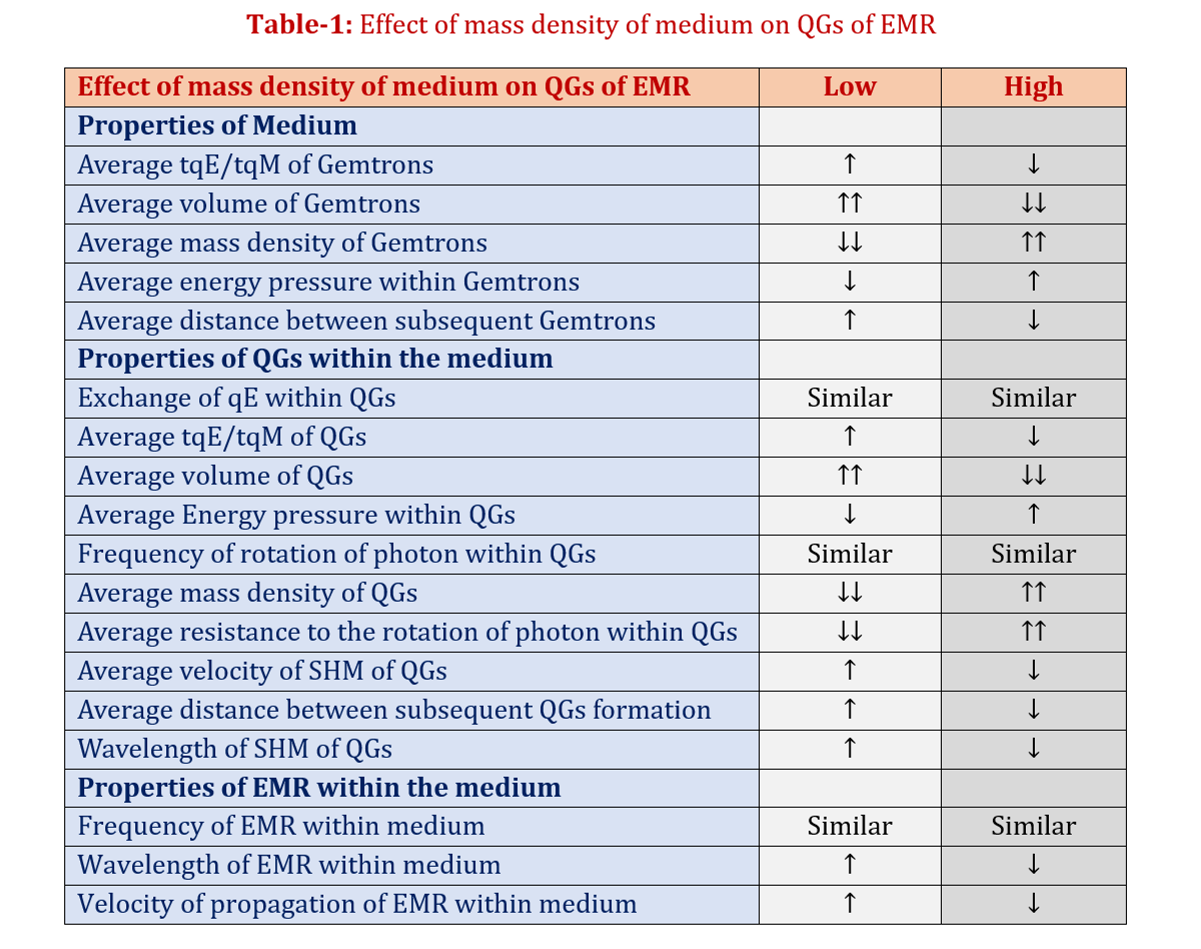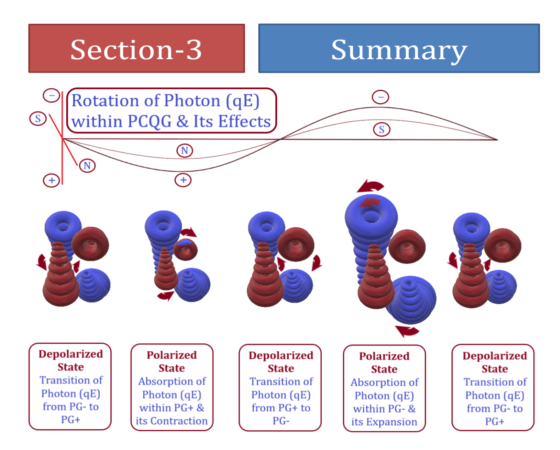EMR (Photon):
Traditional hypothesis:
According to the current understanding, the photon is made up of the definite qE having a definite frequency. During the propagation of photon, it is transformed into a transverse wave known as electromagnetic radiation (EMR). EMR is propagated within the space (or any medium) as oscillating electric and magnetic fields which are generating one another.
Traditionally, it is also hypothesized that the velocity of a photon is constant irrespective of the medium from which it passes. This hypothesis is contradictory to practical observations about the velocity of the photon (EMR) that is changed during its passage from one medium to another medium having different densities. According to the general theory of relativity, this phenomenon is explained by the hypothesis of time dilation and the length contraction during the propagation of photon.
Hypothesis as per O-ToE:
Photon Carrying Quadruple of Gemtrons (PCQG):
According to the O-ToE, photon having definite qE is bound to a quadruple of Gemtrons in which all gemtrons possess similar tqM and tqE. This quadruple of Gemtrons is termed as Photon Carrying Quadruple of Gemtrons (PCQG). It is also hypothesized that qE of the photon is continuously exchanged between four Gemtrons on the definite circular path. This exchange of photon between four Gemtrons is also explained as the rotation of the photon within the system of quadruple of Gemtrons.
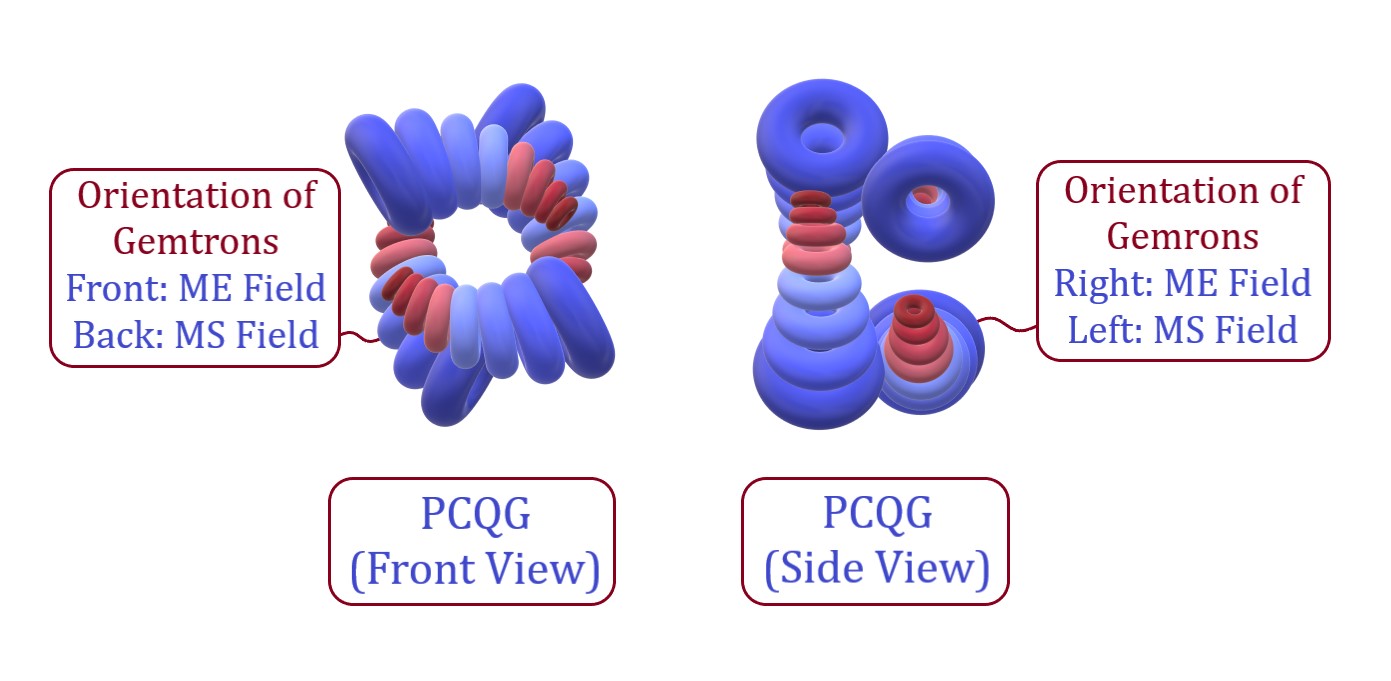
Within PCQG, the pair of Gemtrons (PG) in which the rotation of tqE is in the opposite direction from the rotation of the photon are termed as PG+, whereas the pair of Gemtrons (PG) in which the rotation of tqE is in the similar direction of the rotation of the photon are termed as PG-.
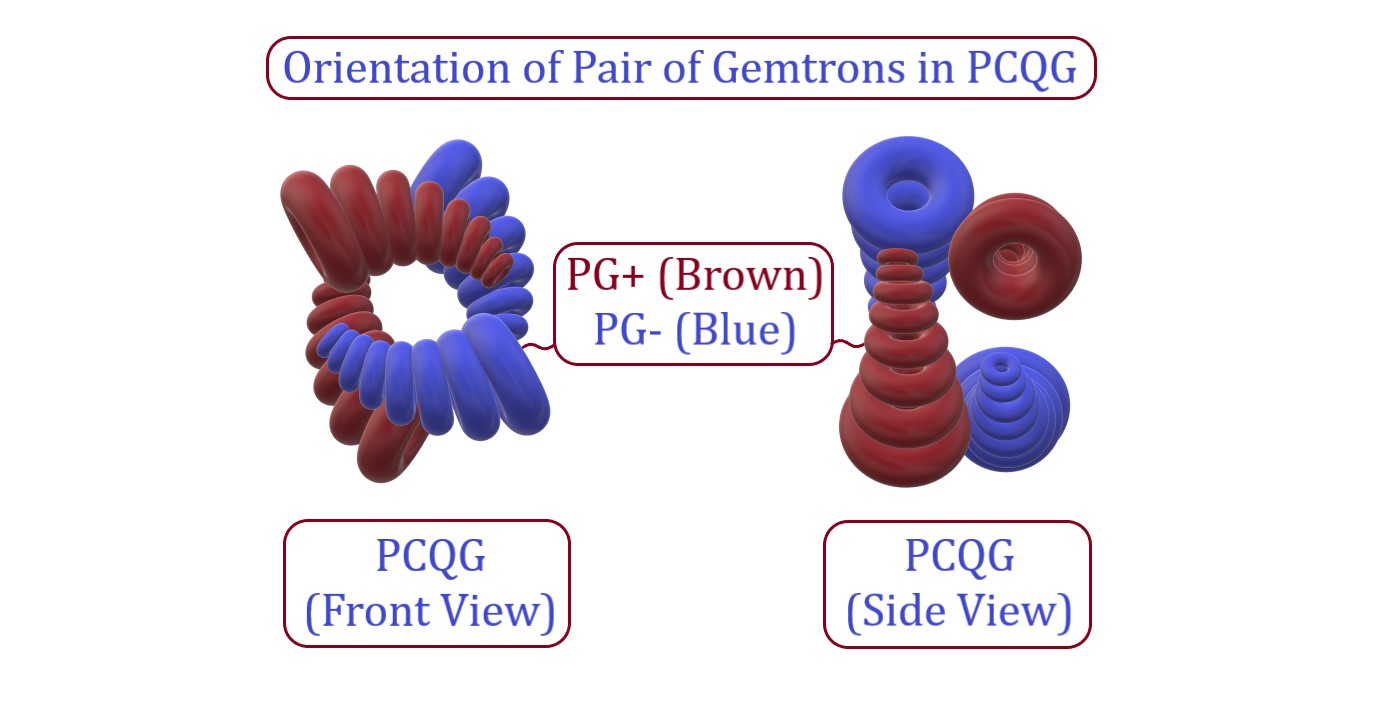
Within PCQG, PG+ and PG- are oriented in a manner that their electromagnetic poles are neutralized by one another. Along with this, qE of Photon is continuously exchanging between PG+ and PG- at the definite frequency.
Absorption of the photon (qE) within the PG+:
Due to the absorption of the photon (qE) within the PG+, the net qE (nqE) of PG+ is decreased due to the movement of qE of photon and tqE of PG+ in the opposite direction. So, nqE/tqM is decreased during the absorption of the photon within PG+.
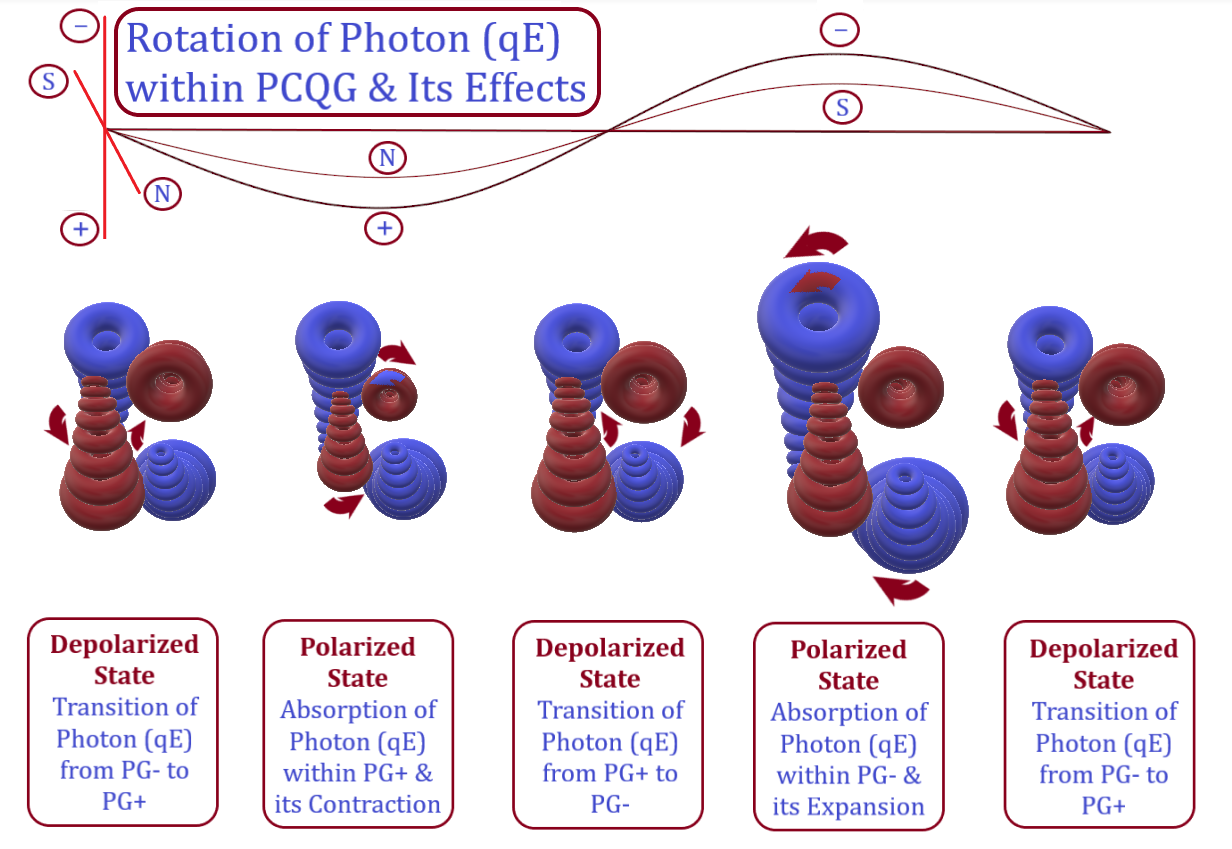
In this state, the net positive charge and the net N-pole are gradually raised to maximum within the PCQG in the perpendicular direction to each other as well as perpendicular to the direction of propagation of the PCQG.
In this state, the PCQG is transformed into the nqE deficient polarized state. Due to the polarization of PCQG, its linear velocity of propagation is approached to zero, as it experiences significant electromagnetic resistance of Gemtrons present on the track of propagation of PCQG.
Absorption of the photon (qE) by the PG-:
Due to the absorption of the photon (qE) within the PG-, the net qE (nqE) of PG- is increased due to the movement of qE of photon and tqE of PG- in the same direction. So, nqE/tqM is increased during the absorption of the photon within PG-.
In this state, the net negative charge and the net S-pole are gradually raised to maximum within the PCQG in the perpendicular direction to each other as well as perpendicular to the direction of propagation of the PCQG.
In this state, the PCQG is transformed into the nqE rich polarized state. Due to the polarization of PCQG, its linear velocity of propagation is approached to zero, as it experiences significant electromagnetic resistance of Gemtrons present on the track of propagation of PCQG.
Depolarized (Electromagnetically neutralized) state of PCQG:
This transition state of PCQG is repeated in between two polarized states of PCQG during the circular rotation of photon at definite frequency.
In this state, photon present outside of four Gemtrons on its circular track of rotation. So, four Gemtrons of PCQG have identical tqE, tqM, and tqE/tqM in this state.
Electromagnetic fields of PG+ oriented in the opposite direction to PG-. So, this state is known as the depolarized (electromagnetically neutral) state.
The PCQG has a maximum linear velocity of propagation due to the lack of electromagnetic resistance of Gemtrons present on the track of propagation of PCQG.
Properties of PCQG:
According to O-ToE, along with the photon having definite qE and definite frequency, PCQG is also made up of the four Gemtrons having the definite tqM and the definite tqE. Therefore, each PCQG possesses a definite amount of dark matter as well as a definite amount of dark energy present in four Gemtrons along with the measurable qE of Photon.
As the dark matter is attracted by the gravitational force of the surrounding massive systems, during the propagation of PCQG, its track of propagation is bent in proportion to the gravitational pull of those massive systems.
During the propagation of PCQG, electric and magnetic fields are produced during its polarized state and they are neutralized during its depolarized state due to the circular rotation of photon with a definite frequency within PCQG.
Impact of the medium of Gemtrons on the propagation of PCQG:
Resistance to the polarized PCQG by the formation of QG within the medium: During the propagation of PCQG in the definite direction, if PCQG transforms into polarized form, the Gemtrons present on the path of PCQG are instantly oriented in a definite manner that they resist the movement of polarized PCQG.
Among the Gemtrons present on the path to which PCQG propagates toward, a similar number of Gemtrons (i.e. four Gemtrons) present on the track instantly exchange similar amount of qE (i.e. equivalent to qE of Photon rotated within PCQG) in between one another to move in the opposite direction to the propagation of PCQG along with the creation of similar electromagnetically polarized structure (Quadruple of Gemtrons (QG)) having similar poles to resist the movement of PCQG by repulsion forces.
Among the gemtrons present on the path from which PCQG passes away, a similar number of Gemtrons (i.e. four Gemtrons) present on the track instantly exchange similar amount of qE (i.e. equivalent to qE of Photon rotated within PCQG) in between one another to move in a similar direction of the propagation of PCQG along with the creation of similar electromagnetically polarized structure (QG) having opposite poles to resist the movement of PCQG by attraction force.
So, Gemtrons (present on the path of propagation of PCQG) are instantly converted into the number of Quadruple of Gemtrons (QG).
Formation of Electromagnetic wave due to propagation of PCQG: Due to propagation of PCQG, every QGs present on the track of propagation of PCQG instantly carry out the linear simple harmonic motion. Due to their linear simple harmonic motion, this electromagnetic disturbance is propagated on the path of propagation of PCQG at the velocity of light in the medium of Gemtrons. So, it is experimentally observed that the electromagnetic wave-like pattern is created having oscillated magnetic and electric fields at the speed of light in the medium.
During the transition of PCQG from depolarized state to polarized state, due to the movement of two QGs directing their similar poles towards each other, the strength of oscillating magnetic and electric fields within QGs are gradually intensified to the maximum along with maximum repulsion forces towards each other at their approaching point. So, they have zero kinetic energy at their approaching point.
During the transition of PCQG from polarized state to depolarized state, due to the movement of two QGs directing their opposite poles towards each other, the strength of oscillating magnetic and electric fields within QGs are also gradually diminished to zero. Both QGs present in the depolarized state at their approaching point. So, they have no interaction between them. They have maximum kinetic energy at their approaching point.
According to O-ToE, within any medium of Gemtrons, the propagation of PCQG produces electromagnetic wave (disturbance) having the definite velocity which is inversely proportional to the mass density of Gemtrons present within that definite medium.
Effect of the mass density of medium on QGs of EMR:
To understand the effect of the mass density of medium on QGs of EMR, it is important to understand the difference in the thermodynamic properties between two mediums having different mass densities.
In higher mass density medium, average tqE/tqM of Gemtrons is lesser along with the lower average volume of Gemtrons as compared to the gemtrons present in lower mass density medium.
So, high-density medium possesses higher average mass density and higher average energy pressure within Gemtrons along with the lower average distance between subsequent Gemtrons as compared to the gemtrons present in lower mass density medium.
If both mediums are transparent for the EMR of the definite energy, the formation of the number of QGs is done instantly on the tract of propagation of EMR within each medium.
Due to the QGs having the photons with similar energy, the properties like average tqE/tqM of QGs, the average volume of QGs, and average energy pressure depend on the properties of gemtrons present in each medium.
